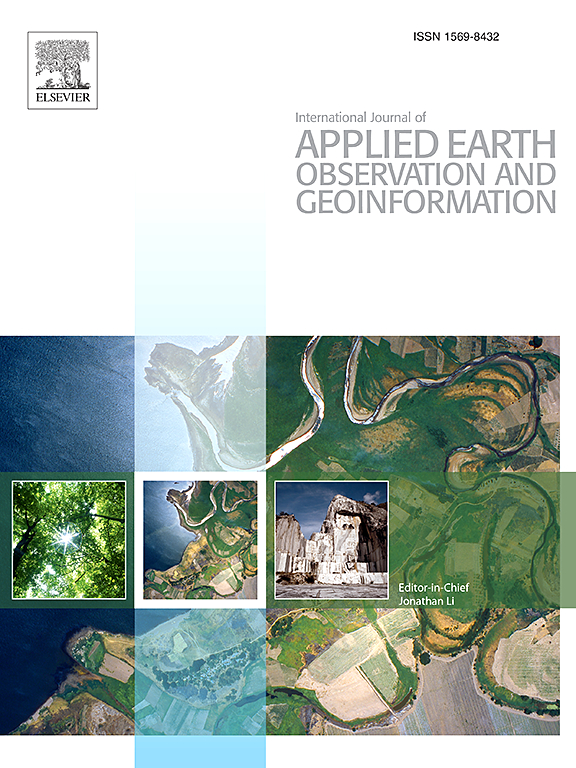Wavelet-based diffusion with spatial-frequency attention for hyperspectral anomaly detection
IF 7.6
Q1 REMOTE SENSING
International journal of applied earth observation and geoinformation : ITC journal
Pub Date : 2025-06-24
DOI:10.1016/j.jag.2025.104662
引用次数: 0
Abstract
Frequency decomposition offers a promising approach for hyperspectral anomaly detection (HAD) by separating anomalies from redundant backgrounds. However, an improper decomposition strategy may cause domain shifts in the low-frequency component (LFC) and excessive suppression of the high-frequency component (HFC), ultimately affecting detection performance. To address those challenges, we propose a novel frequency decomposition framework wavelet-enhanced diffusion framework for HAD, termed as WDHAD. Following a 2D discrete wavelet transformation, the LFC and HFC are processed in parallel: 1) The LFC is handled via a Low-Frequency Diffusion Model (LFDM), which employs a Low-Frequency Denoising Autoencoder (LFDAE) with spatial-frequency attention to recover key features and remove background noise. 2) The HFC is processed through a High-Frequency Enhancement Module (HFEM) that preserves edges and textures to improve anomaly detection. Both components are then fused and passed through a 2D inverse wavelet transformation, with the detection map obtained by a Reed-Xiaoli detector. In addition, a negative log-likelihood noise loss is introduced to model uncertainty. Extensive experiments on six public and two real-world UAV datasets demonstrate that WDHAD achieves robust generalization and cross-domain adaptability. The code will be publicly available at https://github.com/CZhu0066/WDHAD.
基于空频关注的小波扩散高光谱异常检测
频率分解通过从冗余背景中分离异常,为高光谱异常检测提供了一种很有前途的方法。然而,不适当的分解策略可能会导致低频分量(LFC)的域移位和高频分量(HFC)的过度抑制,最终影响检测性能。为了解决这些挑战,我们提出了一种新的频率分解框架,小波增强扩散框架,称为WDHAD。在二维离散小波变换之后,LFC和HFC并行处理:1)LFC通过低频扩散模型(LFDM)处理,该模型采用具有空间-频率关注的低频去噪自编码器(LFDAE)来恢复关键特征并去除背景噪声。2)通过高频增强模块(HFEM)对HFC进行处理,保留边缘和纹理,提高异常检测。然后将两个分量融合并通过二维逆小波变换,得到Reed-Xiaoli检测器的检测图。此外,在模型不确定性中引入负对数似然噪声损失。在6个公开数据集和2个真实无人机数据集上的大量实验表明,WDHAD具有鲁棒泛化和跨域适应性。代码将在https://github.com/CZhu0066/WDHAD上公开。
本文章由计算机程序翻译,如有差异,请以英文原文为准。
求助全文
约1分钟内获得全文
求助全文
来源期刊

International journal of applied earth observation and geoinformation : ITC journal
Global and Planetary Change, Management, Monitoring, Policy and Law, Earth-Surface Processes, Computers in Earth Sciences
CiteScore
12.00
自引率
0.00%
发文量
0
审稿时长
77 days
期刊介绍:
The International Journal of Applied Earth Observation and Geoinformation publishes original papers that utilize earth observation data for natural resource and environmental inventory and management. These data primarily originate from remote sensing platforms, including satellites and aircraft, supplemented by surface and subsurface measurements. Addressing natural resources such as forests, agricultural land, soils, and water, as well as environmental concerns like biodiversity, land degradation, and hazards, the journal explores conceptual and data-driven approaches. It covers geoinformation themes like capturing, databasing, visualization, interpretation, data quality, and spatial uncertainty.
 求助内容:
求助内容: 应助结果提醒方式:
应助结果提醒方式:


